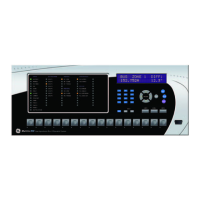5-138 B90 LOW IMPEDANCE BUS DIFFERENTIAL SYSTEM – INSTRUCTION MANUAL
SYSTEM SETUP CHAPTER 5: SETTINGS
5
BUS 1A STATUS — This setting dynamically defines a connection status of a given feeder with respect to the differential zone
(dynamic bus replica). If a given feeder is connected to the zone and its current included into differential calculations, the
FlexLogic operand used for this setting is “On.” If the current is excluded, the FlexLogic operand is “Off.” Typically, this
setting is an appropriately filtered position of an isolator, a breaker, or a tie-breaker.
In the case of an isolator connecting a feeder to a given section of a bus, the isolator monitoring feature produces a
reliable isolator position operand (ISOLATOR 1 POSITION). Typically, the isolator monitoring feature is enabled in the fourth
B90 IED and the ISOLATOR 1 POSITION status operand must be sent over direct input/output communications before it can
be configured as a
BUS ZONE 1A(X) STATUS setting.
Figure 5-73: Bus zone direction setting
For example, assume that B90 IED 4 is used for isolator monitoring while IEDs 1, 2, and 3 are used for protection.
Consequently, the
B90 FUNCTION setting of IED 4 must be set to “Logic” while B90 FUNCTION on the IEDs 1, 2 and 3 must be
set to “Protection.” Normally open and closed auxiliary switches of a given isolator must be wired to the IED 4, and the
Isolator feature must be enabled and configured appropriately.
Assume that the isolator shown as follows is monitored by the Isolator 1 feature. The
ISOLATOR 1 POSITION is the FlexLogic
operand asserted by the isolator 1 monitoring element. This operand must be configured to drive a direct output in order
to send the connection status to IEDs 1, 2, and 3 where the bus replica is being utilized by differential protection. Assume
bit 12 of the message originating at IED 4 is used for this purpose. This is achieved by applying the following settings:
For IED 4:
DIRECT OUTPUT DEVICE ID: “4” (this is the originating device)
DIRECT OUT 12 OPERAND: “ISOLATOR 1 POSITION” (this operand drives output number 12)
The above information is to be received by IEDs 1, 2, and 3. Assume direct input 68 is to reflect the isolator position.
For IEDs 1, 2, and 3:
DIRECT INPUT 68 DEVICE: “4” (message received from IED 4)
DIRECT INPUT 68 BIT NUMBER: “12” (using bit number 12)
Once received, the isolator 1 status (known on IEDs 1, 2, and 3 as DIRECT INPUT 68 On) is used for bus configuration.
For IEDs 1, 2, and 3:
BUS 1E CT: “F7” (the current wired to the F7 terminal)
BUS 1E STATUS: “DIRECT INPUT 68 On”

